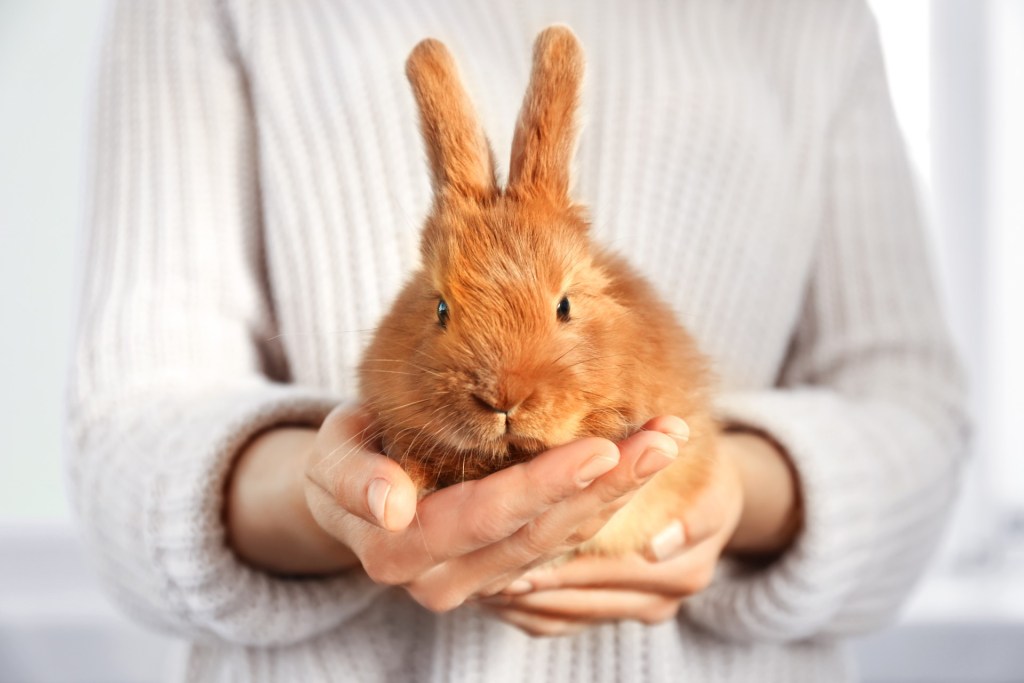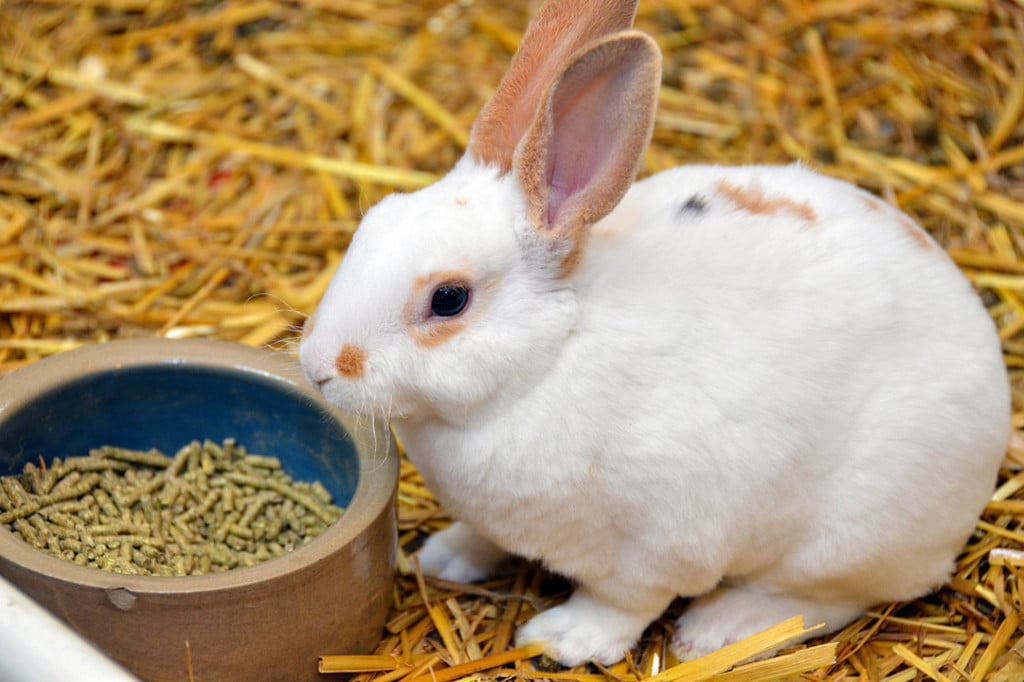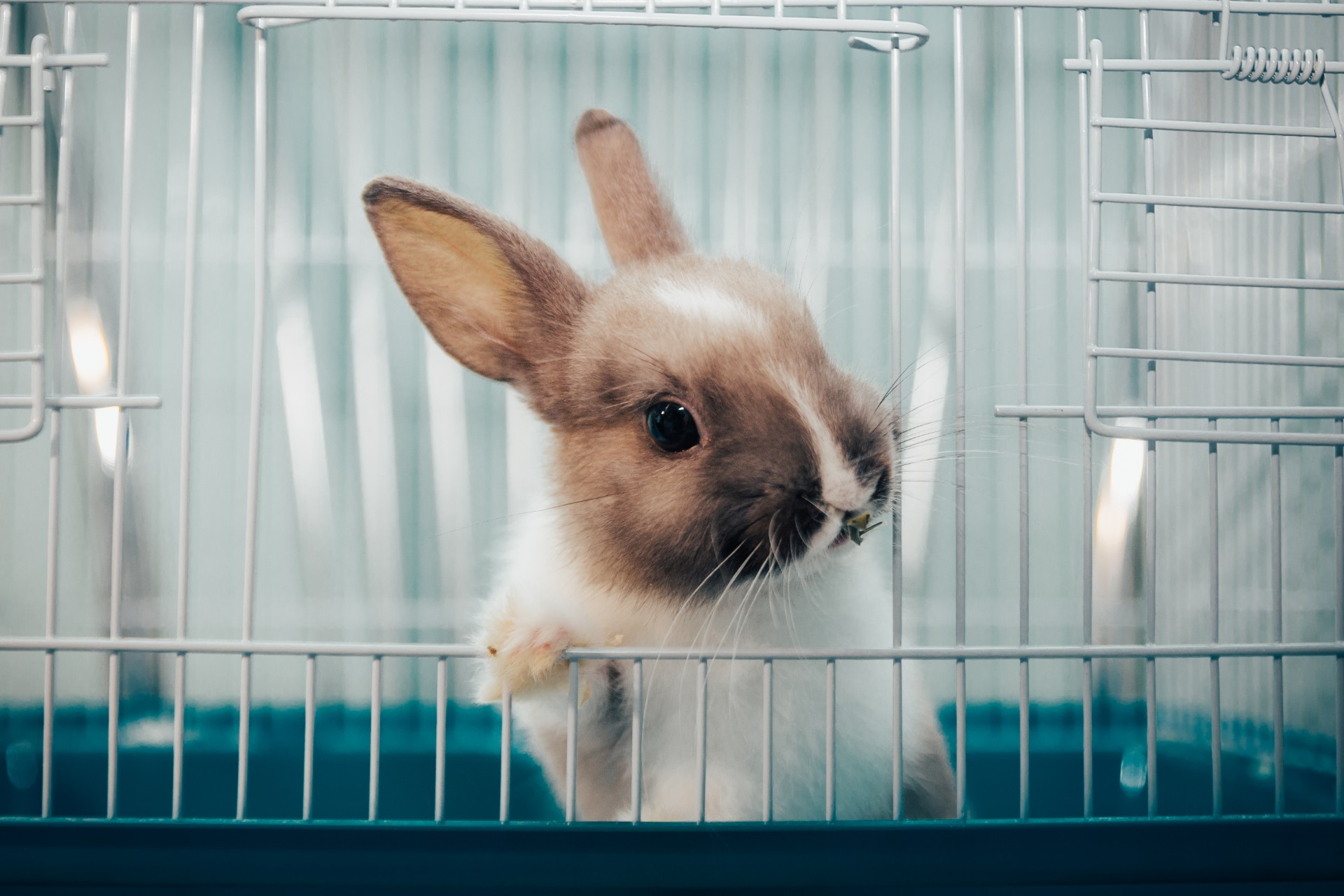Rabbits are interesting pets, but many proud rabbit owners are initially confused about their furry critter's grooming, bathing, and cleaning habits. These cuddly creatures display some strange behaviors, so naturally, their grooming methods are a little different than cats or dogs. We’ll dive into the details of how to properly clean your pet rabbit, from bathing his body and brushing his fur to keeping him spotless overall.

Do rabbits clean themselves?
Like feline pets, rabbits groom themselves with their tongues. First, they’ll lick their paws and use these spit-slick “brushes” to clean other body parts. This helps get rid of shedding fur, dirt, and other surface-level messes. Sounds inefficient? Don’t worry — rabbits have been using this method since the dawn of time, and frankly, it’s simple, but it works.
Moreover, rabbits clean themselves constantly. Like, all day constantly. Your rabbit can handle cleaning himself for the most part, unless he's not feeling well. In this case, a visit to the vet might be the answer — which brings us to our next point.
Is it safe to bathe my pet rabbit?
The short answer is no, it’s not safe to bathe your pet rabbit in a tub full of water. If your rabbit has stopped grooming themselves, don’t resort to a bubble bath, no matter how warm the water feels. In general, the risks that come with bathing a bunny far outweigh the possible benefits.
For instance, according to Rabbit Welfare UK, rabbits may feel unsafe and end up panicking in the water, which can result in several stressful injuries for you and your pet. Bathing-related stress has even been linked to the death of a few pets. Additionally, their fur is notoriously hard to dry, so your pet may be vulnerable to hypothermia or respiratory illnesses if left wet, or even damp.
Still, there are a few instances when your vet may recommend that you wash your rabbit — typically if your bunny has an especially dirty behind! Most likely, a spot wash is all you’ll need, though your vet can provide a prescription shampoo for particularly sensitive areas. Always ask your vet for a shampoo recommendation for your rabbit, as even other pet shampoos are not necessarily safe for your bunny (via Rabbit.org).
Spot cleaning your bunny: A safer option
Spot cleaning lets you clean your rabbit without exposing him to the dangers of a bath. When you do this, you’re cleaning only a specific part of his body, eliminating the risk of both hypothermia and shock-related symptoms.
Step 1: Sit your bunny in a small tub for washing, but remember to empty the water regularly, as rabbits may panic if sitting in too much water. This may also make his bum even harder to dry later, so think ahead before “bath” time. Perhaps you can use the bathtub to avoid this, or even improvise! Drilling a few holes into the bottom of that small plastic tub should allow enough drainage for your bunny to stay comfy.
Step 2: To spot clean your rabbit’s leg, for example, you could dunk just his leg into room-temperature water. For a messy bottom, a damp towel should do the trick.
Step 3: Once dunking your rabbit's leg into room-temperature water, rub in a rabbit-safe or vet-approved shampoo.
Step 4: Gently rinse the leg with the aid of a small dish (via Omlet). No running water, please! It could be too loud and powerful for a lot of rabbits.

How do I get rid of my pet rabbit’s smell?
Here are a few steps to help you get rid of unwanted smells from your bunny.
Step 1: Apply cornstarch baby powder to your rabbit's fur.
Step 2: If the smell hasn’t gone away by applying baby cornstarch powder (scented or not), use some pet towelettes to refresh areas. Pet-safe towelettes prevent sensitivity to potentially harmful ingredients.
Step 3: If the smell isn’t letting up, you might need to clean his cage to remove any yucky odors that are sticking to your pet rabbit.
Step 4: Is a clean cage still not the answer? Your pet rabbit might need his scent glands cleaned. Two of these glands are located around his bottom and they release some undesirable odors when not properly discharged. Use a cotton swab dipped in warm water to clean the glands around your rabbit’s private area. The excretion is typically brown and easy to spot. This simple hygiene routine should significantly reduce any unpleasant smells.
How do I groom my pet rabbit?
The average pet rabbit molts two to three times a year. During this phase, they’ll shed tons of fur. In an attempt to speed up the process and to keep themselves clean, rabbits might groom themselves even more during this molting. Even on a regular day, your rabbit will lose significant amounts of hair.
Step 1: Brush the fur at least once a week even if your rabbit isn't molting. This helps prevent any dangerously large hairballs from forming in your pet's stomach, and it helps the molting process go more smoothly.
Step 2: On the other hand, long-haired rabbits need haircuts and trims to keep their beautiful coat healthy. Again, this also reduces hairballs in their stomachs.
How do I trim my pet rabbit’s nails?
Pet rabbits need nail trims to keep them from getting too long and hurting themselves, you, or other pets. Purchase a rabbit-specific nail trimmer for this task. Check your rabbit’s nails regularly and trim them about once a month or whenever necessary.
Declawing is not recommended for rabbits because they use their nails to move around properly. If you’re nervous about trimming your rabbit’s nails, ask a professional groomer or your vet to demonstrate it a few times until you feel comfortable. They’ll show you great tips like how to hold your pet correctly during the task.

How else can I properly clean my pet rabbit and keep them that way?
Other body parts to keep clean are your rabbit’s ears, eyes, and teeth. Repeat these tasks regularly, and your pet rabbit should stay thoroughly clean.
Step 1: Use a cotton swab to wipe away ear wax and apply a gentle cleaner if necessary.
Step 2: For sleep in your rabbit’s eyes, use a cloth or tissue to wipe it away. Medicated drops might be necessary for some conditions, but always double-check with a vet.
Step 3: Give your rabbit enough treats, such as boards and twigs, to keep his teeth a healthy size. These chew toys wear down your pet’s teeth, which is super important since their teeth grow continuously!
Your pet rabbit is a delicate creature that needs your full care and attention. Luckily, we’ve reviewed some essential grooming routines on how to clean your rabbit, such as brushing his fur, giving him dry baths, and trimming his nails to keep your pet properly clean. One last thing we’ll repeat is to keep the cage and/or the sleeping area clean. Fresh, pellet-free bedding always makes for a cleaner, happier rabbit.
Editors' Recommendations
- A simple guide to what to feed tadpoles in your aquarium
- Is my rabbit pregnant? 5 telltale signs you should know
- Wondering how to take care of a hamster? Here are 8 pet hamster care tips that all beginners need to follow
- Wondering what to feed a baby bird? Here’s how to take care of an orphaned bird
- Best reptile pets: These are the 5 most affectionate reptiles you can welcome into your home



